Temples Haven’t Always Been Announced at General Conference; Here’s a Historical Look at Why
Contributed By Scott Taylor, Church News managing editor
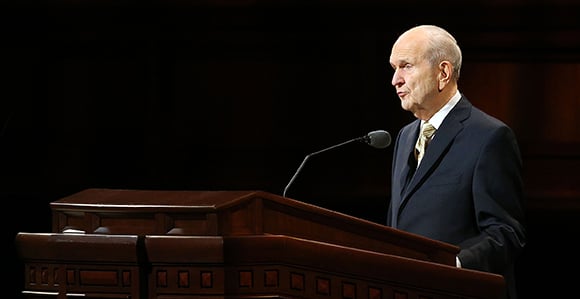
President Russell M. Nelson announces there will be seven new temples during the Sunday afternoon session of the April 2018 general conference. Historically, temples haven’t always been announced in general conference.
Article Highlights
- President Nelson announced 19 temples in 2018, the most announced in a year’s time in two decades.
- The pattern of announcing temples in general conference has changed over the years.
Related Links
If it seems like general conference and the announcement of new temple locations go hand in hand in The Church of Jesus Christ of Latter-day Saints, there are plenty of reasons to think so.
The last 31 temple announcements have come in a conference session, with all but two of the 56 announced over the past decade done from the Conference Center pulpit.
But temple announcements by the President of the Church during general conference have not always been a given. Consider that less than half of the current 201 temples—operating, under construction, or formally being planned—were announced in conference.
Also, while 96 percent of the past decade’s temple announcements were made during a conference session, only 15 of the 48 in the previous decade—or less than a third—were publicized in similar fashion.
While this may make temple announcements in conference seem like a more recent trend, three of the seven oldest operating temples were announced during general conference—the first nearly a century and a half ago.
The Church’s temple announcements during general conference have a varied history—from in-session statements to preconference press conferences, and from the naming of specific cities to a more-general identification by county, country, or even property-development name.
Earliest announcements in conference
The first in-conference announcement came in October 1876, just six months before the dedication of the St. George Utah Temple, the Church’s oldest operating temple.
In a conference address, Brigham Young divided the Utah Territory into three temple districts—members in the south/central region to focus on the temple in Sanpete County announced a year earlier; members in Weber, Davis, Morgan, Salt Lake, Summit, Tooele, and Utah counties tasked with completing the temple in Salt Lake City; and those in the northern Utah counties of Cache, Rich, and Box Elder, along with the southern Idaho valleys of Malad, Soda Springs, and Bear Lake, “to unite your labor and commence as soon as you can to build a temple in Cache Valley.”
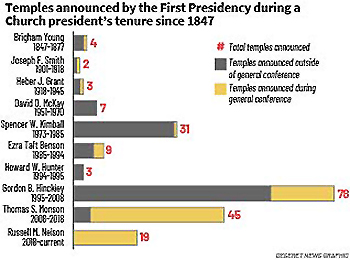
Graphic by Joseph Tolman, Deseret News.
That temple became the Logan Utah Temple, and that conference date of October 6, 1876, is listed as the temple’s official announcement date, although a temple in that area had been projected and proposed unofficially for some dozen years previous.
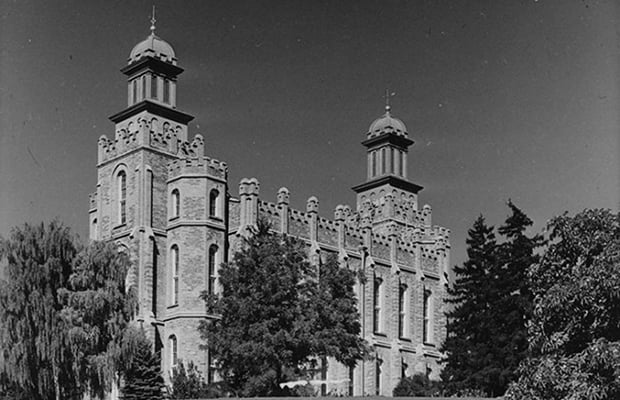
The Logan Utah Temple was dedicated in 1884. The architect was Truman O. Angell, who also designed the Salt Lake Temple. Utah State Historical Society, Deseret News Archives.
In the Sunday morning session of general conference on October 1, 1915, President Joseph F. Smith proposed to “build a temple at Laie, Oahu, Territory of Hawaii,” which received an enthusiastic and unanimous sustaining by those in attendance.
Actually, President Smith—who at age 15 was called as a missionary to the area known in the mid-1850s as the Sandwich Islands—had dedicated the land in Laie for a temple several months earlier, prior to the announcement and even before presenting his plan to the Council of the Twelve.
Inviting Apostle Elder Reed Smoot and Presiding Bishop Charles W. Nibley for an evening walk in Laie, President Smith noted the day—June 1—was the anniversary of Brigham Young’s birth. They walked to the site of a small chapel called “I Hemolele” (Hawaiian for “Holiness to the Lord”), and President Smith announced he felt impressed to dedicate the ground as the site for a temple.
During the October 1919 general conference four years later, President Heber J. Grant announced plans for a temple in Mesa, Arizona. His predecessor, President Smith, had hoped for a temple in the Latter-day Saint colonies of northern Mexico, but that didn’t work out at the time. Arizona was then selected, with the construction of temples in Alberta, Canada, and Hawaii and the outbreak of World War I pushing the Arizona announcement to 1919.

President Heber J. Grant and friends at the dedication of the Mesa Arizona Temple in 1927.
Twelve temples and more than a half-century later came the announcement of the Mexico City Mexico Temple, with an official date given as Saturday, April 3, 1976—the first day of the general conference that year.
While there is no mention of the temple nor its announcement in the archived texts of conference addresses, the May 1976 Ensign magazine issue states: “The next new temple will be built in Mexico City, President [Spencer W.] Kimball announced at the opening of general conference. He said the decision came following a meeting with priesthood leaders in Mexico in mid-March.”

Graphic by Joseph Tolman, Deseret News.
The 1980s and early ’90s
In the early 1980s, temples weren’t announced in general conference but on the Wednesday before the start of the first session. That was the pattern for April 2, 1980; April 1, 1981; and March 31, 1982.
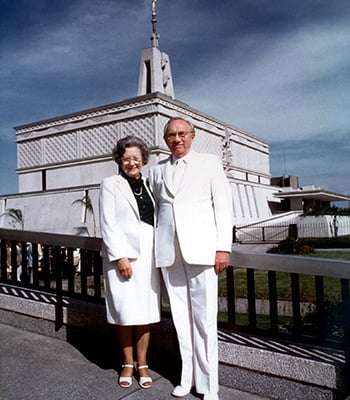
President Gordon B. Hinckley and his wife, Sister Marjorie Pay Hinckley, stand in front of the Mexico City Mexico Temple in 1983. Photo by Gerry Avant, Deseret News.
The 1980 announcement of six new locations—conducted in front of the Christus statue in the Temple Square North Visitors’ Center—included plans for temples in Tonga and Tahiti and the reassigning of the 1977-announced temple location of Pago Pago, American Samoa, to Apia, Samoa. The previous location provided easier travel from many South Pacific islands, while the new location was central for more Samoan Saints.
As a First Presidency counselor to President Kimball, President Gordon B. Hinckley started the Saturday morning session of the 1984 April conference with the sustaining of General Authorities and Church officers, naming Russell M. Nelson and Dallin H. Oaks to fill vacancies in the Quorum of the Twelve Apostles. He followed the sustainings by listing sites for the construction of five new temples.
Temple announcements didn’t return to general conference until eight years later. President Hinckley, then a First Presidency counselor to President Ezra Taft Benson, followed leader sustainings in the October 1992 general conference with an update on the construction of several temples. He then announced new temples for Hong Kong; Hartford, Connecticut; and “another temple in Utah County to relieve the pressure on the Provo Temple.”
That location was identified at the conference six months later as Church property in American Fork, Utah, home of the present Mount Timpanogos Utah Temple. Also, the Hartford location was withdrawn in 1995 in favor of temples in Boston, Massachusetts, and White Plains, New York. Ironically, the White Plains site was later withdrawn as well, with a temple for Hartford again announced in 2010.
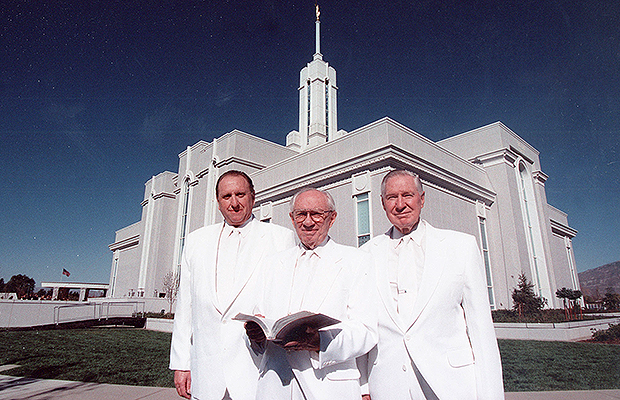
From left: President Thomas S. Monson, First Counselor in the First Presidency; President Gordon B. Hinckley; and President James E. Faust, Second Counselor in the First Presidency, stand in front of the Mount Timpanogas Utah Temple circa 1997. Photo by Tom Smart, Deseret Morning News.
During the April 1993 conference, President Hinckley updated the status of previously announced temples, adding “we are in the process of acquiring property in Spain and at least three other nations.” That statement, given April 4, 1993, was the official announcement for the Madrid Spain Temple.

Madrid Spain Temple. Photo courtesy of the Deseret News.
A similar location-by-nation announcement was part of the October 1995 priesthood session, held on September 30. President Hinckley—then President of the Church—reviewed temple construction and planning statuses and added, “We are working on the possibility of another in Venezuela.”

Graphic by Joseph Tolman, Deseret News.
That September 30 date became the announcement date for the Caracas Venezuela Temple and the Boston Massachusetts Temple.
Smaller temples, many temples
After publicizing two temples in the April 1997 conference, President Hinckley made one of the most memorable in-conference announcements regarding new temples during the October 1997 priesthood session, on October 4.
Reviewing in-progress temples, he noted the announcement of temples in Houston, Texas, and Porto Alegre, Brazil—both have September 30 dates, several days earlier, for their official announcement dates.
He continued by announcing a move to add smaller temples in more remote areas. These temples, he said, would meet temple standards and provide all the ordinances but be without the laundries and eating areas of other temples. They might have a reduced operating schedule and share parking with a neighboring stake center.
The smaller temples would require a shorter construction time and be built at a fraction of the cost, he said, noting some could be built for the same cost of a larger temple’s annual maintenance and operation budget. They could also be expanded in the future.
President Hinckley announced “such structures” to be built in Anchorage, Alaska; in the colonies in northern Mexico; and in Monticello, Utah, then added the determination “to take the temples to the people and afford them every opportunity for the very precious blessings that come of temple worship.”
The small-temple momentum carried over to the next general conference, as President Hinckley concluded the Sunday afternoon session on April 5, 1998.
“I take this opportunity to announce to the entire Church a program to construct some 30 smaller temples immediately,” he said. “They will be in Europe, in Asia, in Australia and Fiji, in Mexico and Central and South America and Africa, as well as in the United States and Canada.”
He added the 30 to the 17 temples already going forward in construction or planning, and then did some math to present a bold challenge. “This will make a total of 47 new temples in addition to the 51 now in operation,” he said. “I think we had better add two more to make it an even 100 by the end of this century, being 2,000 years ‘since the coming of our Lord and Savior Jesus Christ in the flesh’ (Doctrine and Covenants 20:1).“
Thirty-six temples were announced between that moment and the next time a temple announcement came in general conference—when President Hinckley proclaimed the rebuilding of the Nauvoo Illinois Temple on April 4, 1999. He announced six more temples in the April 2000 conference.
The past 15 years
President Hinckley announced only three more temples in a conference setting before his passing in early 2008. In the October 2004 conference, he identified a temple for Twin Falls, Idaho, and a third temple in the Salt Lake Valley—eventually the Draper Utah Temple.
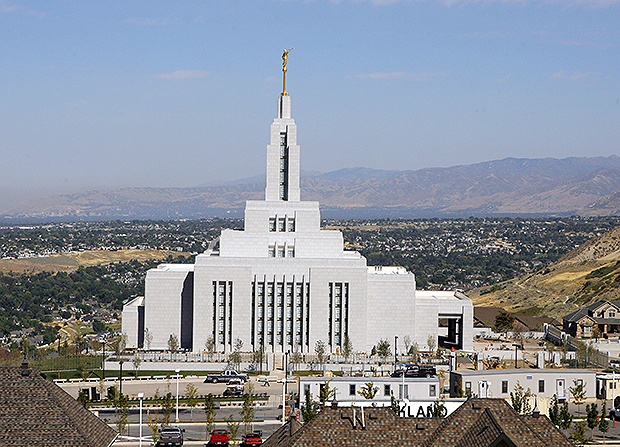
Draper Utah Temple on September 26, 2008. Photo by Scott G Winterton, Deseret News.
In October 2005, he acknowledged two potential sites provided by developers “in the west and southwest areas of the valley. … The first one on which we will build is in the so-called Daybreak development, and this morning we make public announcement of that.” That temple is the Oquirrh Mountain Utah Temple.
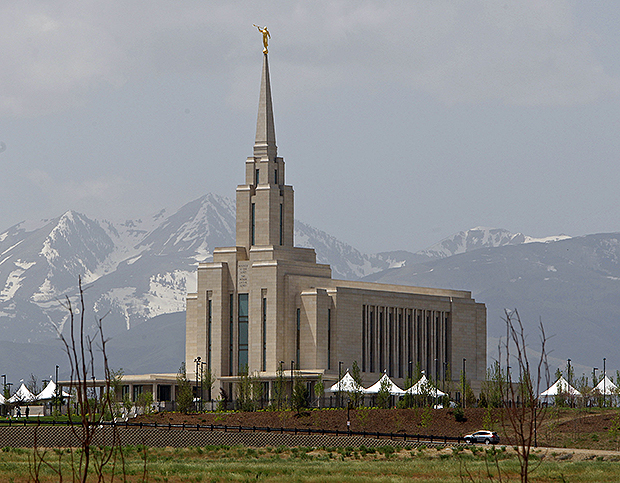
Exterior of the Oquirrh Mountain Utah Temple Wednesday, May 20, 2009, in South Jordan, Utah. Photo by Tom Smart, Deseret News.
Of the 45 temples announced during the tenure of President Thomas S. Monson, 40 were done in a conference session. For the first six years of his decade-long tenure, he announced temples at least once a year—twice in 2011—in his conference-opening addresses during the Saturday morning sessions.
In addition to announcing five locations in October 2009, he also noted that 83 percent of the Church members at the time lived within 200 miles (approximately 320 kilometers) of a temple.
In October 2011, President Monson announced the rebuilding of the burned Provo Tabernacle as the city’s second temple, as well as five other cities, including a formal acknowledgment of “moving forward on our plans for a temple to be built in Paris, France.” A First Presidency statement several months earlier reported the intent to purchase property on the outskirts of Paris, but the conference session’s October 1 date is listed as the official announcement for the Paris France Temple.
President Monson also announced the formation of the General Temple Patron Assistance Fund, helping to provide a one-time visit to the temple for members who otherwise would not be able to go to the temple, because of distance or financial means.
Following a two-year break during which the Church focused on completing temples rather than announcing new ones, President Monson identified new temple locations in the Sunday morning sessions of April general conference in 2015, 2016, and 2017, the final three years of his presidency.
In his first year leading the Church, President Russell M. Nelson announced seven temples in the April 2018 conference and another 12 six months later, in October—both times during his conference-concluding remarks of the Sunday afternoon sessions. In the latter conference, he also announced the Church’s intent to renovate the Salt Lake Temple and other pioneer-era temples.
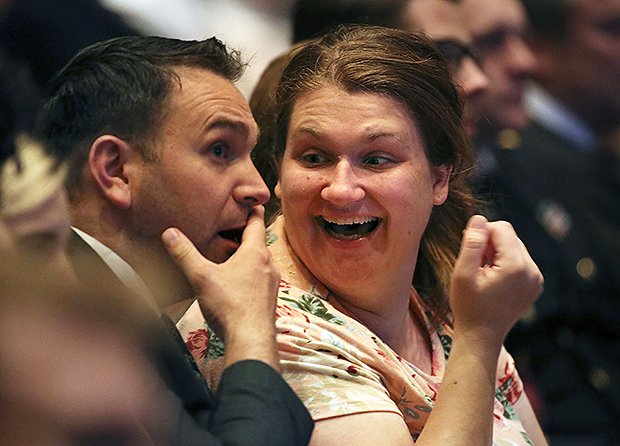
Erik Ramsay and Amy Ramsay react to the announcement of 12 new temples during the Sunday afternoon session of the 188th Semiannual General Conference of The Church of Jesus Christ of Latter-day Saints in the Conference Center in downtown Salt Lake City on Sunday, October 7, 2018. Photo by Kristin Murphy, Deseret News.
The 12 new locations in October marked the most ever identified in one setting—in or out of conference—and the 19 total locations marked the most in one year over a two-decade span. It was also the first time in seven years that temples were announced in two same-year conferences.
Similarly to his predecessors in announcing temples, President Nelson offered invitations to attend the temple and promised blessings of greater love and harmony in the home, a deeper desire to care for eternal family relationships, and increased faith in the Lord and a greater ability to follow Him as a disciple.

This graphic displays temples announced during general conference. Graphic by Joseph Tolman.
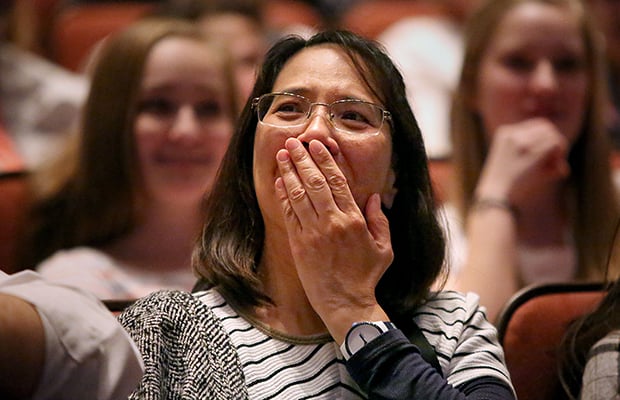
Cheryl Reyes reacts to President Russell M. Nelson's announcement that there will be seven new temples around the world during the Sunday afternoon session of the 188th Annual General Conference at the Conference Center in Salt Lake City on Sunday, April 1, 2018. Photo by Kristin Murphy, Deseret News.
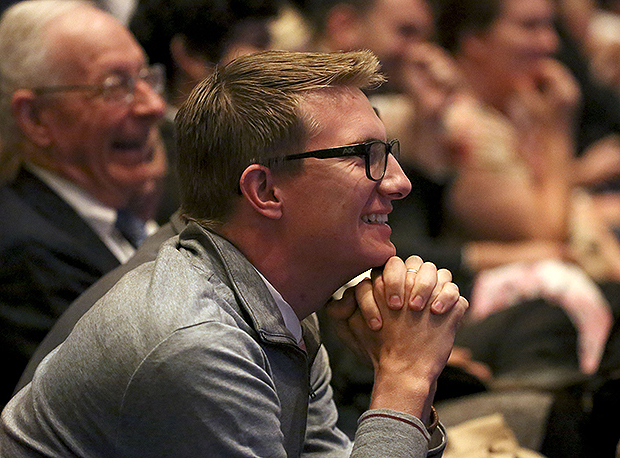
Mark Richey reacts to the announcement of 12 new temples during the Sunday afternoon session of the 188th Semiannual General Conference of The Church of Jesus Christ of Latter-day Saints in the Conference Center in downtown Salt Lake City on Sunday, October 7, 2018. Photo by Kristin Murphy, Deseret News.
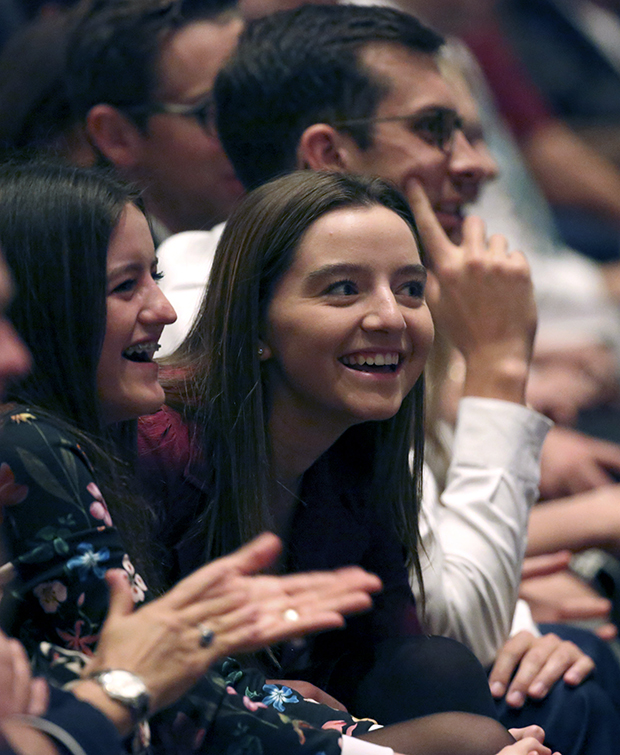
Conference-goers react to the announcement of 12 new temples during the Sunday afternoon session of the 188th Semiannual General Conference of The Church of Jesus Christ of Latter-day Saints in the Conference Center in downtown Salt Lake City on Sunday, October 7, 2018. Photo by Kristin Murphy, Deseret News.
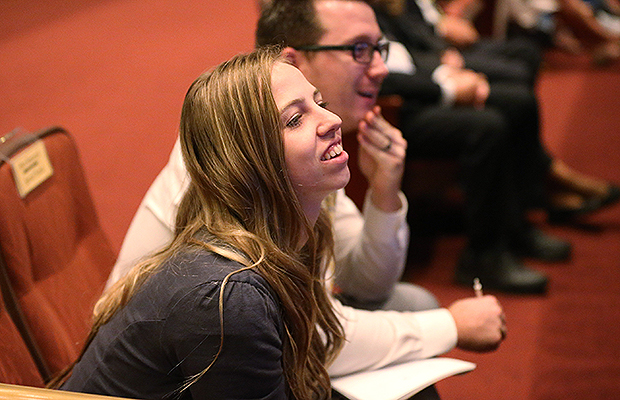
Joyce Owens listens to new temple announcements during the Sunday afternoon session of the 188th Semiannual General Conference of The Church of Jesus Christ of Latter-day Saints in the Conference Center in Salt Lake City on Sunday, October 7, 2018. Photo by Jeffrey D. Allred, Deseret News.
